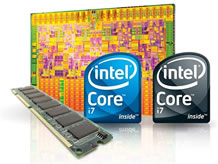Final Thoughts
Starting with the basics, our general performance tests showed strong bandwidth gains when increasing the memory clock frequency. However, the WinRAR performance test and CINEBENCH seemed to find DDR3-1333 memory to be the sweet spot rather than the more speedy 1600MHz modules.
For those interested in games, the very nature of gaming applications means these will rely more heavily on the GPU than other components like memory. In other words, we saw very little difference in performance when comparing triple-channel DDR3-800 memory versus DDR3-1600.
It was interesting but certainly not unexpected to have programs like SiSoftware and EVEREST constantly reporting a huge difference in memory bandwidth, yet the real-world test results remained much the same. This was particularly evident when removing memory modules to test single, dual, and triple-channel performance.
During this test, SiSoftware reported that a single module provided the Core i7 with a memory bandwidth of 8GB/s, two allowed for 16GB/s, and three reached 23.5GB/s. The real-world applications results were largely unaffected by this drastic change in memory bandwidth. The single module configuration delivered almost the same performance as the triple-channel configuration in the applications and games we tested.
While Core i7 processors will logically perform its best when using triple-channel memory, we were amazed by how little the performance was affected when using two or even just one memory module. The same remained true for memory frequency, generally the difference between DDR3-1066 and DDR3-1600 memory was kept to a minimum.
It should be reinforced that this all applies to desktop and gaming performance. It would only make sense for scientific and other similar applications that rely more heavily on memory subsystem performance to show marked improvements as more bandwidth becomes available.
The state of the market
Currently a 6GB DDR3-1600 (8-8-8-21) memory kit is going to set you back at least $250, whereas a DDR3-1066 (7-7-7-20) kit can be had for ~$150. Given the small performance difference between these two, we feel you would be mad to pick up the more expensive option. That said, most users will just be fine running a 3GB triple-channel kit, which can be had for less than $100. This could be good news for those "budget" Core i7 920 builds.
At this stage the only other question that remains to be answered is how overclocking affects memory performance? But unlike older platforms that use a FSB, the Core i7 doesn't need high speed memory to reach its maximum overclocking potential. Based on what we've seen, the Core i7 965 Extreme Edition processor, for example, can be overclocked to 4GHz or higher while using DDR3-1066 memory.
At this point those looking to build a Core i7 system should consider buying low-latency DDR3-1066 memory, or at most 1333MHz memory.
The only other choice you need to make is whether you want to buy a 3GB of 6GB kit, and honestly, if you are a gamer buying the latter is probably a waste of money, especially with current DDR3 prices that will only drop in time. But if you are thinking fancy for your new Core i7 setup, 6GB definitely sounds way better on paper.
